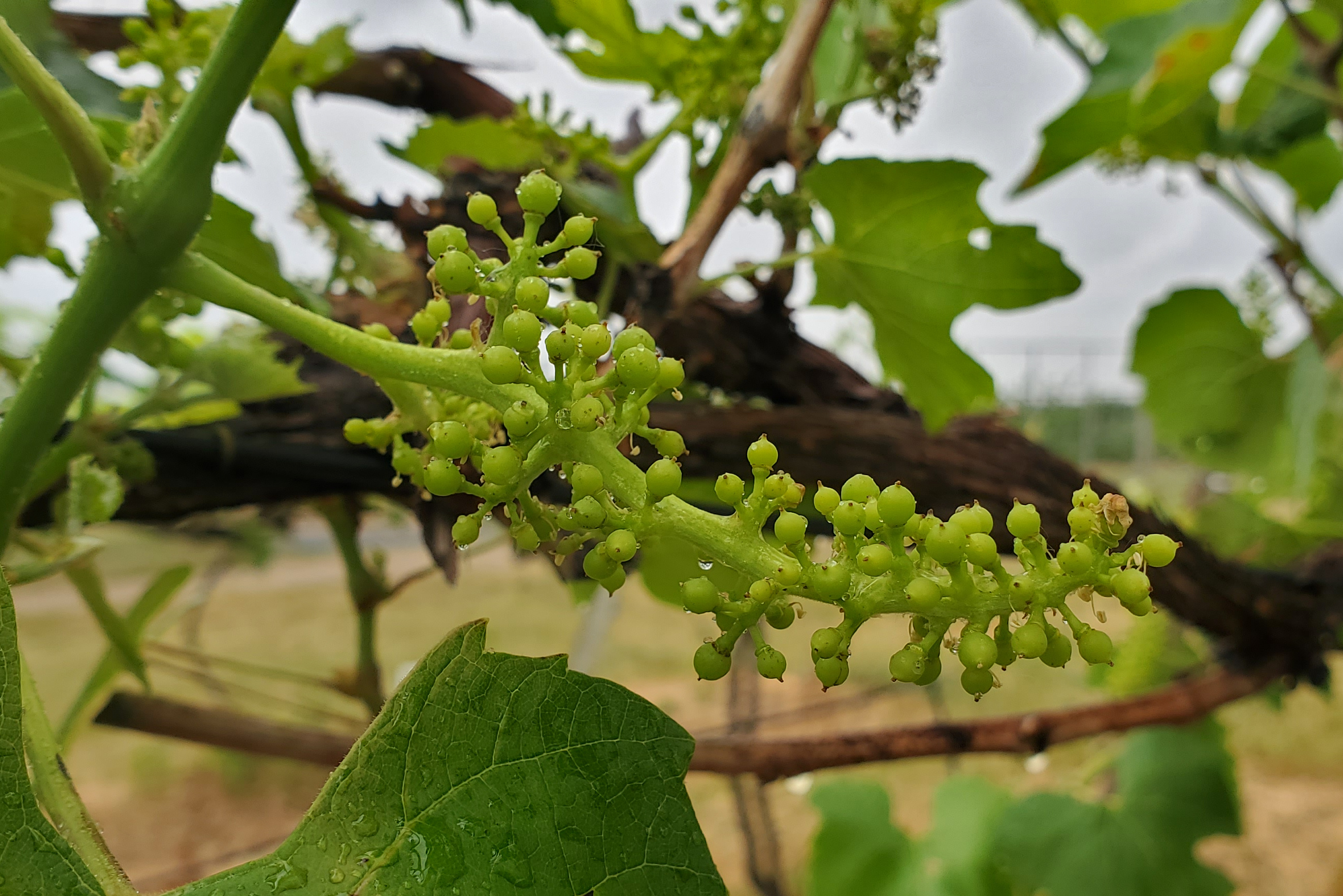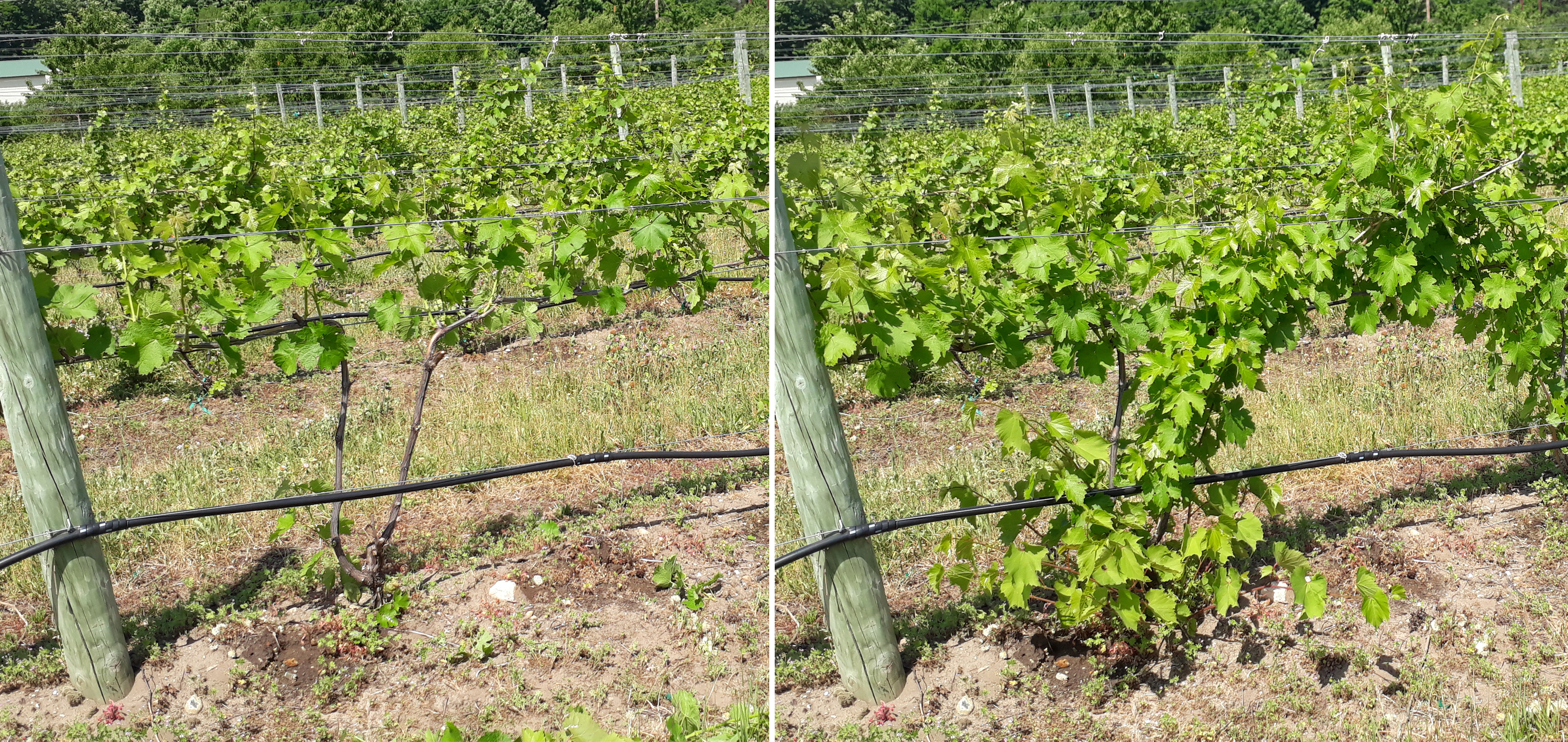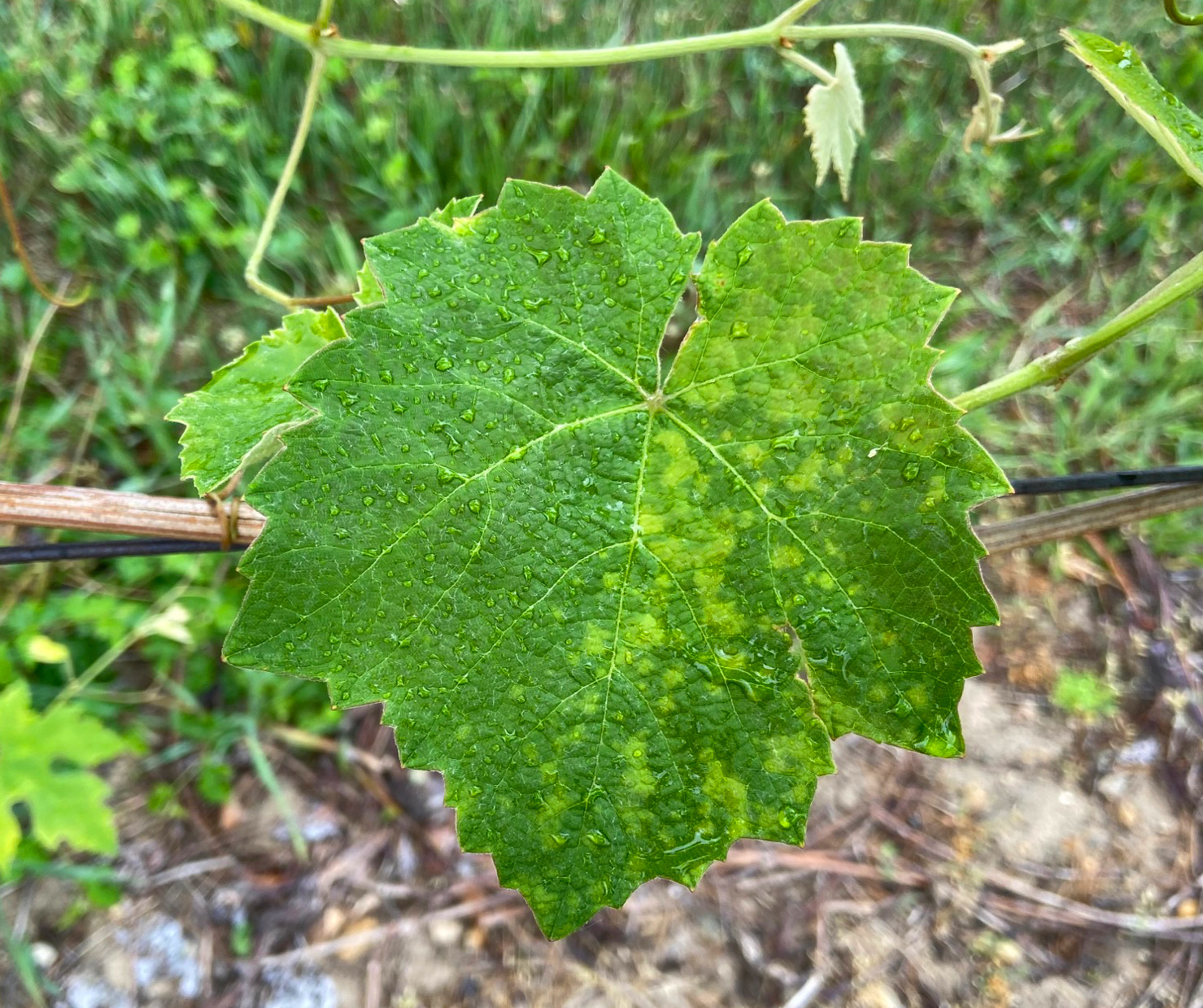Michigan grape scouting report – June 9, 2021
Grape bloom has started in southern Michigan. Bloom on hybrid wine grapes and early vinifera should begin soon in northern parts of the state. Now is a critical time to control diseases.

Weather
Last week started with temperatures around 70 degrees Fahrenheit climbing to near 90 F by the weekend. Southeast Michigan saw up to a quarter inch of rain last week on Wednesday. The rest of Michigan was dry. The hot, dry conditions of last week shifted to a humid, unstable pattern for this week in the southern tier of the state. Rain was recorded in southwest Michigan starting Monday, June 7. The chances of scattered afternoon showers and thunderstorms will continue through Friday for southern Michigan, spreading statewide on Saturday. Highs will be in the mid-80s for the entire week.
Soils are still very dry, especially in southwestern portions of the state. At this time, most of lower Michigan is in a D1 level drought. Portions of Van Buren and all of Allegan counties and areas just to the north and east are in a D2 (severe) drought condition. This is extremely unusual at this time of year.
With the warm week, we picked up a lot of growing degree days (GDD) last week: 140-145 GDD base 50. The southwest region is 203 GDD base 50 ahead of the northwest region. Statewide, we are 110-130 GDD base 50 ahead of the five-year average.
|
Northwest Michigan GDD summary from March 1 - June 7, 2021 | |
|---|---|
|
Northwest stations |
GDD 50 F |
|
Petoskey (Petoskey) |
427 |
|
Traverse City (NWMHRC) |
467 |
|
Old Mission (Old Mission) |
447 |
|
Average for northwest region |
450 |
|
Average last week |
311 |
|
Southern stations |
|
|
Benton Harbor (SWMREC) |
669 |
|
Lawton (Lawton) |
677 |
|
Fennville (TNRC) |
562 |
|
Average for southwest region |
653 |
|
Average last week |
506 |
|
Romeo (Romeo) |
615 |
|
Average for southeast region |
628 |
|
Average last week |
487 |
Vine growth
In southwest Michigan, vineyards not impacted by the early May freezes are at or very close to bloom. Niagara and some earlier hybrids closer to the lake are finishing bloom. Most vinifera are close to bloom, with some cultivars, like pinot noir, showing traces of bloom on Monday, June 7. Most other cultivars are somewhere in between.
Southwestern Michigan sites impacted by the freezes had varying levels of primary bud loss or foliar damage, with some areas as high as 90%. In many of these sites, clusters are elongating and separating. Some secondary bloom has been recorded on Niagara grapes in Berrien County. In these freeze damaged sites, a reduced pest and disease program may be warranted. See “Pest management approaches in a winter or freeze damaged grape vineyard” from Michigan State University Extension for recommendations.
In northern vineyards, many sites have shoots that are 6-12 inches long. Clusters are beginning to elongate and separate. The northwest had similar temperatures during early May, but the grapes were behind phenologically when compared to vines in the southwest, so they have survived the spring cold events without any significant damage.
See this chart for grape growth stages.

Horticulture
A quality soil test or a previous year’s petiole analysis is important in understanding what nutrients the vineyard needs. Early season nutrient management will most likely include nitrogen, zinc and boron. In addition, potassium and magnesium may also need to be managed at this time. Growers should be careful with the amount of nitrogen applied in their vineyard. Too much can cause flowering to be delayed or aborted and increase vegetative growth with detrimental effects on fruit quality (canopy shading), cold hardiness and sensitivity to foliar and cluster diseases. Too little nitrogen will result in reduced vigor, stunted growth and poor fruit quality.
Grapevine nutrient status is determined by three methods: Observing visual symptoms, analyzing vine tissue samples and performing soil tests. The pre-bloom and bloom time is a very important moment of the vine growing season to scout for visual symptoms of potential problems and deficiencies. Tissue analysis is the preferred tool for monitoring the nutrient status at the time of bloom, to identify potential nutrient deficiency observed in the vineyard. Tissue analysis may be performed on different types of vine tissues (petiole and leaf), however, petiole tissue analysis is recommended in our region because of the lack of historical data for nutrient range recommendations of leaf blade tissue.
If you observe leaf symptoms and a potential nutrient deficiency, collect petiole samples from vines reporting symptoms and from asymptomatic vines. The two samples should be sent and analyzed separately for comparison.
This year, the extensive water stress is complicating how to monitor a vineyard for vine water stress or for nutrient deficiencies. During long periods of water stress vines will transport water and nutrients from the older, basal leaves of the growing shoots to newer leaves on the apical portion of the shoots as well as to developing clusters. Vines suffering severe water stress will develop symptoms of nutrient deficiency in basal leaves, potentially resulting in leaf loss.
Shoot thinning is underway in southern vineyards now and is beginning in northern vineyards. Shoot thinning is an important canopy management tool to improve air circulation, minimize disease pressure, reduce shading, and improve spray penetration. The right time for shoot thinning time is when the shoots are 5-12 inches long. For vinifera cultivars, leave between three and five shoots per foot of canopy, with fewer shoots in red varieties and more in white varieties. Hybrid cultivars are more vigorous and ripen earlier, so it is suggested to leave four to six shoots per linear foot of canopy, for higher levels of yield per acre. For Concord and other native cultivars, the number of shoots per foot of canopy can reach as many as 15 shoots, especially in divided canopy trellis systems.
This is also the time to start to clean trunks from the extra shoots that can emerge from buds that were hidden beneath the bark. Suckering is an important early season operation as well, and one of the most challenging. It seems as if suckers have two weeks (for each variety) when they are easy to knock off, and this is the time of the season.

Diseases
June 2 and 3 were infection events in southeast Michigan and Monday and Tuesday of this week were infection events in southwest Michigan. At this time of year, disease focus is on phomopsis, black rot, anthracnose and powdery mildew. Before bloom, fungicides that include broad-spectrum/contact fungicides like the EBDCs (FRAC M3) and captan are effective and function similarly to dormant applications by sanitizing the vineyard. If a grower is organic, early season oils may also be used, which try to suffocate overwintering fungal spores and infected tissues. Early season management should target phomopsis, black rot, anthracnose and powdery mildew, and as we approach bloom, downy mildew. Bloom is an absolutely critical time to control all of the above-mentioned diseases.
With the exception of powdery mildew, these spring disease infections typically require rain events. It only takes 0.1 inches of rain above 50 F to trigger a possible infection. Viticultural practices that reduce canopy wetness such as good irrigation timing, leaf removal and good weed management can reduce many of these diseases in a vineyard. Typically, DMIs (FRAC 3), captan and EBDCs (FRAC M3) are effective for phomopsis, black rot, and anthracnose.
If powdery mildew is the only concern, there are a number of products that are effective (FRAC codes 3, 7, 11, 13, U8, 50, and U13 as well as sulfur). A combination of fungicides containing these FRAC classes should also be effective while helping with resistance management. Remember as you choose a fungicide check the guide for potential phytotoxicity of certain sprays on Concord grapes especially (this has been particularly noted for fungicides like Revus Top). Phytotoxicity risk is higher with high temperatures and quickly growing vines.
Downy mildew can cause fruit infection and late season defoliation. During this time of year, grower focus should be on fruit infection which occurs during bloom. Flowers remain susceptible until two weeks after bloom. When making a chemical application, sprays should be timed prior to bloom and at bloom for optimal control. Downy mildew is caused by a fungal-like organism, so many site-specific systemic fungicides that target other spring diseases do not work on downy mildew. Effective fungicides for downy mildew include products in FRAC codes 11, 21, 40 and 45 as well as phosphorus acid salts and some biologically-based products.

As the season continues, it is important to remember to manage fungicide resistance and avoid applying similar products back-to-back. This is particularly important with site-specific systemic fungicides. To reduce the development of resistance with systemic fungicides:
- Do not make more than two applications per season of the same FRAC code.
- Do not make two consecutive applications of the same FRAC code.
- Rotate with unrelated fungicides in a different FRAC code that have efficacy on the target pathogen.
- Include a contact multisite fungicide into a program (e.g., sulfur, captan, oils or biological fungicides).
Insects
For southern Michigan grape growers, the insects to be on the lookout for at this time are rose chafer and potato leafhopper. Rose chafer damage has been recorded in Van Buren County. They can be found feeding on leaves and clusters. Potato leafhopper have been reported on other crops in Michigan already, and so both should be expected in vineyards soon. Potato leafhoppers feed on the undersides of leaves. These are only a challenge in certain sensitive winegrape cultivars. Most cultivars are very tolerant of potato leafhopper damage and control isn’t often warranted.
Male grape berry moth numbers are still high in southwest Michigan. Wild grape bloom is used as biofix for grape berry moth models. Record the date when 50% of the clusters on wild grape are at 50% bloom. This date can be entered into the grape berry moth model in Enviroweather to predict when egglaying will start.
Wild grape bloom was widespread in areas of Berrien County on May 25 and was observed in Van Buren County on May 29. With the variability in bloom date that can occur from site to site, it is important to scout for wild grape bloom on your farm to determine your local biofix.
In southwest Michigan, protection of clusters from larvae is focused in late June or early July when egg laying by the second generation of this pest starts. In high pressure sites where this pest has been a problem in recent seasons, early treatment for protection of the clusters at bloom in mid-June may also be warranted. Product selection can be guided by what other pests may be present, such as potato leafhopper, rose chafer, etc. Treatment recommendations for all of these insects can be found in the MSU Fruit Pest Management Guide (E-154).
Tumid gallmaker detection continues to increase in hybrid wine grapes in southwest Michigan. This insect was an issue for some growers in susceptible vineyards last year during early cluster development. Scouting for early detection is key for this insect. For small vineyards, hand picking and removal of infestations can be an effective management technique. If there is a high infestation or if clusters are affected, Movento is an effective treatment. It works by moving into the plant and metabolizing to create the toxin. This should be applied at the first sign of infestation to provide enough time for it to get into the vine and be converted into the toxin. Movento needs to penetrate the waxy leaf surface, so application with a penetrating adjuvant is essential to get good control.
Grape cane girdler damage has also been reported in southwest Michigan. This weevil can produce damage that looks similar to some tumid gallmaker damage. It produces red galls that usually have a slit or opening on one side on shoots just above the nodes. While the damage is noticeable, it rarely impacts yield.
Regional and national news outlets have been reporting on Brood X of the periodical cicada lately. This insect emerges once every 17 years. It is only expected in south central and southeastern portions of Michigan, but is not expected to be an issue for growers. We do not expect periodical cicadas to be a significant concern for grape growers in Michigan, but if you are interested, check out this article on the periodical cicada.
Upcoming meetings
Our regular Southwest Michigan Monday Fruit IPM Updates are available online. You need to register to receive the Zoom link and password for these meetings. The webinars are free and one pesticide applicator credit is available for each meeting. We had over 70 growers attending our Monday meetings last year.
Related articles
- Southwest Michigan Fruit Update – June 8, 2021
- A Mobile Guide for Grape IPM Scouting in North Central and Eastern U.S.
- Early season vineyard disease management
- Early season vineyard management
- Michigan grape scouting report – June 2, 2021
- Periodical cicadas are emerging: Should Michigan fruit growers be concerned?
- Pest management approaches in a winter or freeze damaged grape vineyard



 Print
Print Email
Email
